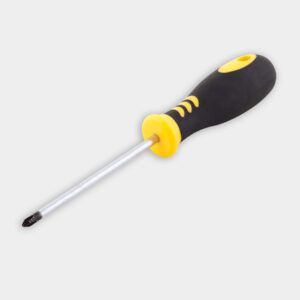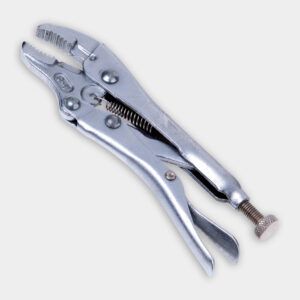We may be compensated if you purchase through links on our website. Our team is committed to delivering honest, objective, and independent reviews on home products and services.
Project details
Skill
Cost
Estimated Time
Replacing an outdated ceiling light can improve a room’s ambiance, but is it safe? Homes built before 1985 often used wiring rated for temperatures up to 60 degrees Celsius (140 degrees Fahrenheit). Some lightbulbs can generate heat exceeding this threshold, potentially causing wire insulation to fray and crack over time. This degradation could lead to arcing and, in worst-case scenarios, electrical fires. Given the risks associated with electrical work, this project should be handled by a licensed electrician to ensure safety and compliance with modern standards.
In this guide, we’ll cover the process of safely replacing a ceiling light and address important factors such as wiring temperature ratings. In the video above, Ask This Old House master electrician Heath Eastman demonstrates the correct way to upgrade a ceiling light fixture in a 1960s home by updating the wiring to meet modern building codes.
*Cost data was sourced via HomeAdvisor.
Identifying Your Wiring Type in Your Lighting
To determine the temperature rating of your home’s wiring, look for these indicators:
- Cloth-covered wiring is not rated for 90 degrees Celsius.
- Plastic wiring labeled “Type NM” is rated for 60 degrees Celsius.
- Plastic wiring labeled “Type NM-B” is rated for 90 degrees Celsius.
What You’ll Need to Replace a Ceiling Light
Before beginning the replacement process, collect the following items:
- Screwdriver
- Wire strippers
- Pliers
- Wire nuts
- Voltage tester
- New light fixture
- NM-B cable (if needed for upgrading)
- Junction box (if needed)
Make sure to turn off the power at the circuit breaker before doing anything else. Use a voltage tester to confirm the absence of electricity, and wear safety glasses and gloves.
Removing the Old Ceiling Fixture
Remove any globes or shades from the fixture and unscrew the mounting screws holding it to the electrical box. Carefully lower the fixture to access the wiring. Disconnect the wires, typically by unscrewing wire nuts.
Once the old fixture is removed, examine the wiring in the electrical box. If you find cloth-covered or Type NM wiring, you’ll need to upgrade to NM-B cable for the new fixture.
Installing the New Ceiling Fixture
With the old fixture removed and the wiring inspected, you’re ready to install the new ceiling light.
Upgrading the Wiring (If Necessary)
If your wiring is outdated, here’s what you need to do:
- Push the old wiring back into the ceiling.
- Cut a section of the old wiring away from the fixture.
- Install a new junction box in the attic or ceiling space.
- Connect the old wiring to the new NM-B cable in the junction box.
- Run the new NM-B cable to the existing electrical box.
Connecting the New Fixture
Once you know your wiring is updated and compatible with your new light fixture, follow these steps to connect the fixture:
- Strip the ends of the wires.
- Connect the ground wire (usually green or bare copper) to the ground screw.
- Connect the neutral wire (typically white) to the white wire from the ceiling.
- Connect the hot wire (usually black) to the black wire from the ceiling.
- Secure all connections with wire nuts.
Mounting the New Fixture
Carefully tuck all wires into the electrical box. Align the mounting holes on the fixture with those on the electrical box and secure the fixture with the provided mounting screws. Install any shades, globes, or decorative elements before inserting the light bulb(s) according to the fixture’s specifications.
In the video, Eastman demonstrates these steps, emphasizing the importance of proper grounding and secure connections.
Understanding Temperature Ratings and Fixture Placement for Ceiling-Mounted Fixtures
Ceiling-mounted fixtures with bulbs close to the junction box pose the greatest risk of overheating. The heat generated by the bulbs can cause the insulation on the wires to become brittle and break down over time.
Chandeliers and other fixtures with bulbs positioned farther from the ceiling typically present less risk of overheating the wiring. When selecting a new fixture, consider its design and how it might affect the temperature of the wiring in the junction box. You can consult a lighting designer or electrician to confirm that your choice of fixtures will adhere to safety regulations.
Choosing the Right Light Bulbs for Your Ceiling Light
While the fixture demonstrated in the video uses LED bulbs, which generate minimal heat, the socket can still accommodate standard incandescent bulbs. Always follow the manufacturer’s recommendations for bulb type and wattage to prevent overheating. Exceeding this limit can lead to damaged wiring and increased fire risk.
Fixtures have varying wattage limits based on their design and intended use. Read the specifications provided by the manufacturer and consult with a licensed electrician if you’re unsure.
Additional Installation Tips for Your Ceiling Light Fixture
Here are a few more tips to help you safely install your new ceiling light fixture:
- Ensure the junction box is securely mounted to the ceiling. A loose box can cause the fixture to wobble, creating potential hazards.
- Use appropriate box covers to prevent dust and debris from entering the electrical connections.
- Use wire nuts that are appropriately sized for the wires you’re connecting. Overusing or underusing wire nuts can lead to poor connections.
- Double-check all connections before tucking them back into the junction box. Loose wires can create sparks that might result in a fire.
- After the installation, turn the power back on at the circuit breaker.
- Use the switch to test the new fixture. If it doesn’t turn on, switch off the power and recheck all connections.
Replacing a ceiling light can enhance your home’s lighting, but it’s crucial to prioritize safety throughout the replacement process. Understanding wiring temperature ratings, following proper installation techniques, and choosing appropriate fixtures and bulbs ensures your new ceiling light is successfully and safely installed. We recommend consulting a licensed electrician to guarantee a code-compliant installation.
Resources:
Eastman installed the 12-inch Oil Rubbed Bronze 2-Light Ceiling Light manufactured by Hinkley Lighting.
Eaton and Eastman Electric provided expert assistance with this segment.


